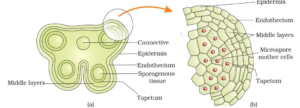Sexual Reproduction In Flowering Plants MCQ/Objective Questions Chapter 2 Biology Class 12
Odd out the non-ornamental flower plant
- a. Rose
- b. Tulip
- c. Money-plant
- d. marigold
The scientific farming of flower is:
- a. Horticulture
- b. Sericulture
- c. Floriculture
- d. Apiculture
The site for sexual reproduction in a plant is:
- a. Leaves
- b. Apical bud
- c. Flower
- d. Stem
The male organ of the plant that produces pollen is:
- a. Androceium
- b. Gynoceium
- c. Petal
- d. Sepal
In some plants viz. marigold numerous small flowers (florets) aligns on a floral disc. This is called:
- a. Pollination
- b. Inflorescence
- c. Fertilization
- d. None
How many compartmets/thecas are there in a typical angiospermic anther:
- a. One
- b. Two
- c. Three
- d. Four
Which among these is a nourishing layer of an anther that provide nutrition to developing pollen grain?

- a. Epidermis
- b. Endothecium
- c. Middle layers
- d. Tapetum
Which among these represent a male gametophyte?
- a. Anther
- b. Pollen grain
- c. Microsporangium
- d. Stamen
Hardest layer of a pollen grain that can withstand high temeperature and harsh chemical conditions is:
- a. Exine
- b. Germ pore
- c. Intine
- d. None
Which of the following plant part can be preserved as fossils?
- a. Leaves
- b. Stem
- c. Pollen grains
- d. Seeds
How many cells are there in a pollen grain of most angiospermic flower during shedding?
- a. one
- b. two
- c. three
- d. four
A place in exine of pollen grains which lacks sporollenin is:
- a. Intine
- b. Cytoplasm
- c. Vegtetative cell
- d. Germ pore
At which temperature pollen gains can be stored for years?
- a. 0°C
- b. -50°C
- c. -196°C
- d. -273°C
In a plant which among these is motile?
- a. Male gamet
- b. Female gamet
- c. Both
- d. None
Transfer of pollen grain from anther to stigma is called:
- a. Pollination
- b. Fertilization
- c. Inflorescence
- d. None
When transfer of pollen gain from anther to stigma occurs in the same flower, the phenomenon is called
- a. Autogamy
- b. Homogamy
- c. Geitonogamy
- d. Xenogamy
In which case a plant will produce enormous number of pollen grains
- a. Self-pollinating cleistogamous plant
- b. Plant pollinating via birds and bees
- c. Plant pollinating via wind
- d. None
Which character among these is the feature of a wind/water pollinating flower?
- a. Odorless flower
- b. No nectar
- c. colorless flower
- d. All three
Continued self-pollination may lead to:
- a. Hybrid vigor
- b. Large fruit size
- c. Inbreed depression
- d. None
Which among these donot encourage outbreeding?
- a. Development of anther and stigma at different time
- b. Placement of anther and stigma at a different position
- c. Self-incompatibility
- d. Dioceious flowers
- e. Cleistogamous flowers
Pollen tube enters the ovule through
- a. Chalazal end
- b. Micropyle
- c. Hilum
- d. None
Foolowing prevent contamination of unwanted pollen grain during artifical hybridisation
- a. Emasculation of pollen grain
- b. Bagging of flowers
- c. Both
- d. None
Double ferilization includes:
- a. Fusion of male gamet with an ovum
- b. Fusion of one generate cell with two polar nuclei
- c. Both
- d. None
What is triple fusion?
- a. Fusion of male gamet with female gamet
- b. Fusion of male gamete with two polar nuclei
- c. Inhibition of pollen tube by the ovary
- d. None
Which part of a monocot seed form stem and leaves?
- a. Radicle
- b. Plumule
- c. Coleoptile
- d. Coleorrhiza
Pea and groundnut seeds consume the endosperm formed during fertilization completely. So, their seed are
- a. Albuminous
- b. Non-albuminous
- c. Hollow
- d. None
In some seeds like those of black-pepper and beet remnants of nucellus is also persent. This nourishing structure forms:
- a. Endosperm
- b. Perisperm
- c. Ectosperm
- d. Episperm
Seed has a hard coat on its cover. Necessary water and oxygen during the germination come through:
- a. Chalazal end
- b. Micropyle
- c. Hilum
- d. None
A parthenocarpic fruit (seedless fruit)is fruit:
- a. Without endosperm
- b. Without seed coat
- c. Formed without fertilization
- d. None
Seeds without fertilization is:
- a. Parthenocarpy
- b. Apomixis
- c. Polyploidy
- d. None
See also:
Sexual Reproduction In Flowering Plants MCQ/Objective Questions Chapter 2 Biology Class 12
Ref: Ch 2.